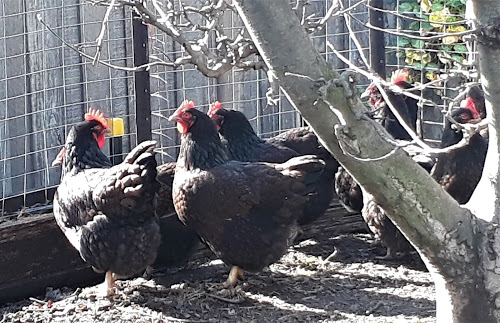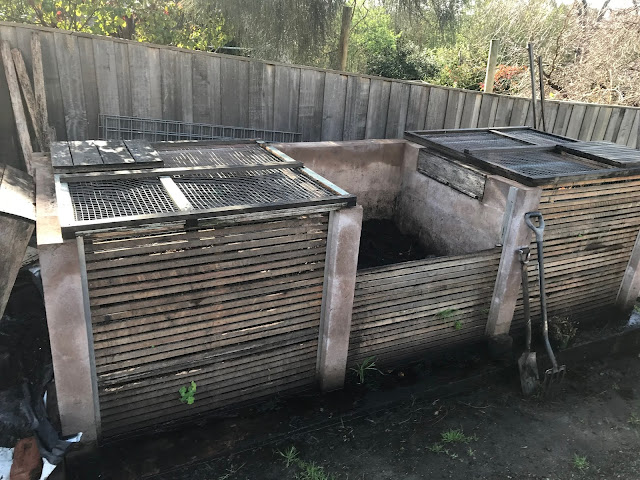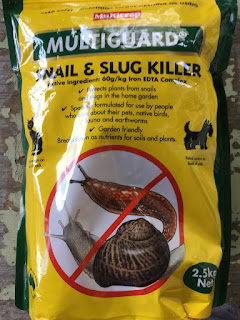Visit - Liz -September 2020
The night before the first Food Garden visit in the Covid19 era, the wind howled and the rain drummed on roofs all over Hobart. But true to form, the morning of the visit dawned sunny and bright and many of us made our way to West Hobart where Liz has a charming market garden.
Because of physical distancing rules, there was a limit of 20 people, and there was a second group of 20 who visited a few hours later. This worked really well and we all enjoyed our visit very much.
Amazingly, Liz manages this garden all by herself. She spends most of her time every day in the garden and sells her produce to 5 high-end restaurants as well as seedlings to the public every Sunday.
Here is Max interviewing Liz about her garden.
Liz chooses what she grows carefully, since it ideally has to have a short growing time and a high sale value. So she grows broad beans for much of the year, not for the beans but for the leaves. When the broad beans reach about 30 cm tall, she cuts them off and they regrow, giving her plenty of leaves to sell.
The asparagus is poking its heads out of the ground.
And there are long rows of pretty lettuce.
Liz has a good system of growing her crops: In her glass house she raises the seeds in punnets. She gets a lot of her seed from "Royston Petrie" because she can buy in bulk there which is cheaper, although they don't have as interesting a range as other companies. She also buys seed from "The Lost Seed", "Seedfreaks",and "4 Season Seeds". When the seedlings are big enough they go outside to harden on raised tables, after which they go in the garden beds. This gives her a good supply of seedlings to go in whenever she needs them.



To reduce the amount of weeding she has to do, Liz has come up with a clever solution. After preparing the soil in her beds she puts down the soaking hoses. They are made by "Premier Extrusions' and their website has an instruction manual for it, which is really good, see the link here:
Premier Extrusions . They are sold by the trade name Leeaky Hose. The 'Hose Factory' and 'Brierly Hose and Handling' both sell these hoses. She then puts a layer of weed mat (bought at Permathene) over the top into which she has burned rows of holes. Into these holes she plants her seedlings, using a garden stake to make the planting hole. Some beds have 4 rows of holes, other have 6, depending on which crop has to go in. The weed mat can be reused again and again.
Liz mixes her fertiliser herself. She uses 25 kg blood and bone, 5 kg potash, and at a guess 2 x 2kg Greek yoghurt containers of kelp meal and about 2 to 3 cups of MgSO4. She also adds lime each time she fertilises a bed.
In the larger of her two glass houses, Liz's tomato seedlings are growing nicely.
And outside, there is a wide variety of seedlings, ready for selling or planting out.
Along the beds where peas are going to be growing up frames, there were some small plants, protected by metal cages. Many people were curious what Liz had growing there. It turns out they are edible Shungiku or Garland Chrysanthemums (Chrysanthemum coronarium). Their leaves are used as greens in many countries including in asian and greek cuisine.

For her own enjoyment, and the eggs, Liz has a small flock of Barnevelder hens. She raised them from some fertilised eggs bought from Down South Farm in the Huon Valley. Find them here:
Down South Farm
Liz has had problems with rats, and she has now built a rat proof compost setup. The floor is a poured concrete slab. Liz said it might have been a god idea to slope the slab so that the water drains off, but if she had to factor planning that in on top of everything else, she might still be in the planning phase! As it is, only a few inches at the bottom end up a bit wet. Some people say you have to have contact with the soil to get worms, but as Liz's compost is full of worms, she is happy with it as it is. Three of the sides are concrete blocks, and the front and top are slatted timber and fine metal mesh. The partition between the three compartments is a bit lower for ease of turning the compost from one compartment to another.
There is a website called
http://www.urbanfarmplans.com/ which has a plan for a rat-proof, timber compost bin with pavers as a base. This is where Liz started with her design.
The front yard is small, but no space is wasted. Liz has 4 long garden beds, (one of which is currently full of Miner's Lettuce) surrounded by a square of espaliered apples.

The snails can be a problem in anything with soft leaves. Liz uses a garden friendly slug killer called Multiguard Snail and Slug Killer. Its active ingredient is Iron.
Everybody enjoyed meandering through this little piece of paradise in West Hobart.
People were happily browsing on the produce table, and many of us went home with some treasure.
Altogether, a brilliant first visit after our enforced break, leaving everyone keen for more.
A big thank you to Liz for opening her garden to us and Max and Gaye for organising and making it happen!






















No comments:
Post a Comment
Note: Only a member of this blog may post a comment.